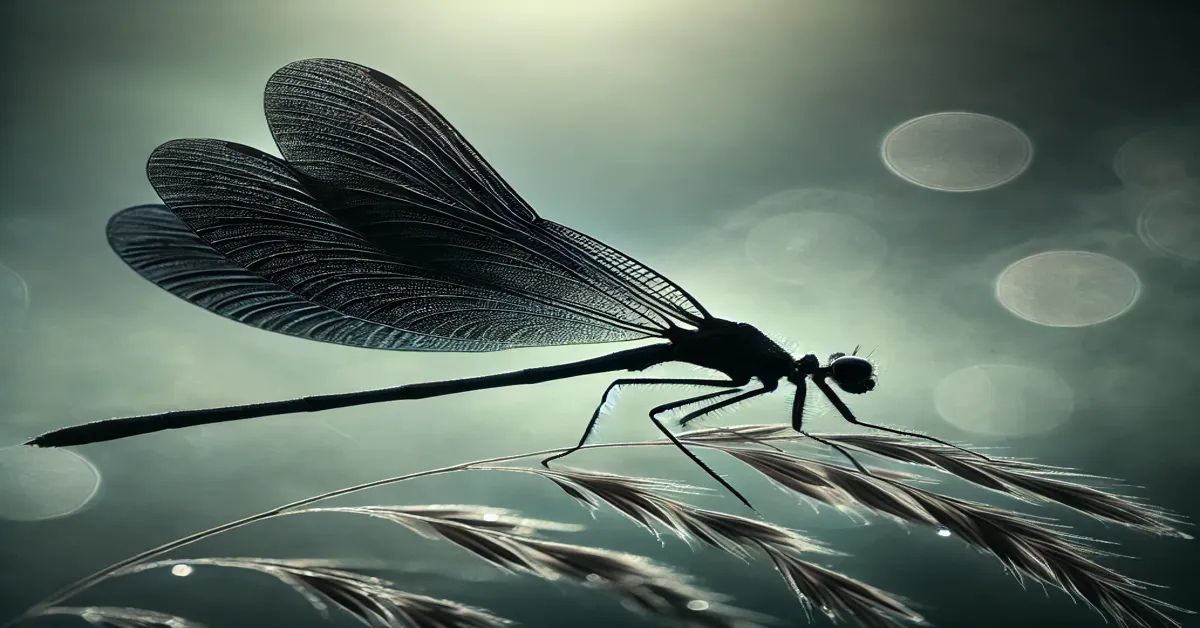Dragonflies are iconic insects that captivate with their agile flight, vivid colors, and intricate wing patterns. Among them, black dragonfly stands out for its unique coloration and behavior. With their striking dark wings and bodies, the black dragonfly is intriguing both scientifically and visually. They play critical roles in maintaining ecological balance within freshwater ecosystems, serving as predators that help control insect populations and contribute to biodiversity.
In this article, we explore the world of the black dragonfly, focusing on their preferred habitats, adaptations, ecological roles, interactions with other species, and the conservation challenges they face. We will discuss how these dragonflies fulfill essential ecological functions, the symbolism they hold in various cultures, and the environmental factors influencing their survival. By understanding the environmental niche of black dragonflies, we gain insight into their contributions to ecosystem health, and biodiversity, and our broader understanding of freshwater habitats.
Black Dragonfly Species and Identification
The term “black dragonfly” refers to a variety of dragonfly species with black or predominantly dark coloration. This dark color may appear on their bodies, wings, or both, contributing to their unique visual appearance and environmental adaptations. Some of the most common black dragonfly is the black saddlebag (Tramea lacerata), black pennant (Celithemis eponina), and the ebony jewelwing (Calopteryx maculata), which is technically a damselfly but shares similar habitats and behaviors.
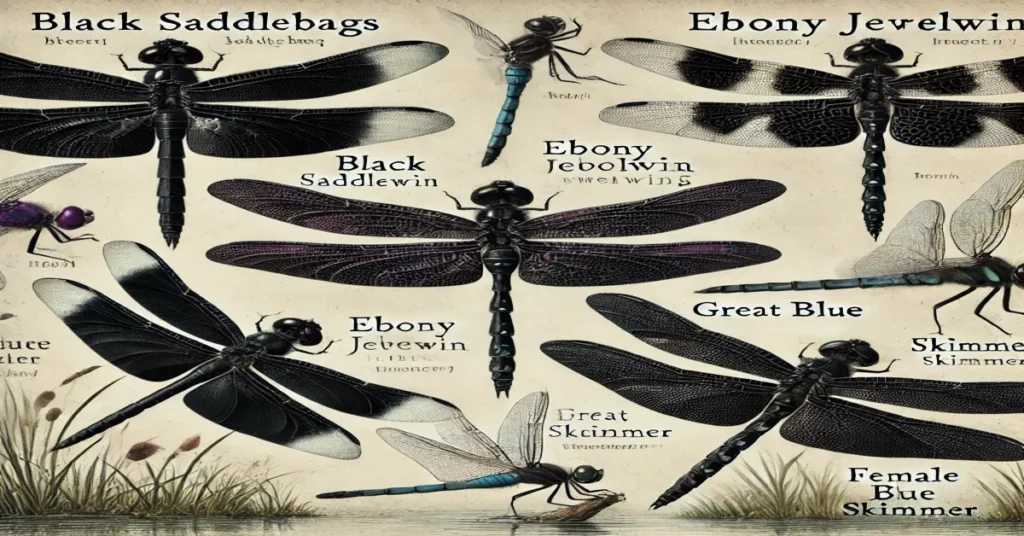
1. Common Black Dragonfly Species
Each black dragonfly species has distinctive characteristics and habitats, although many share certain traits, such as their preference for slow-moving or still water and their role as insect predators.
- Black Saddlebags (Tramea lacerata): Named for the distinctive black patches on their wings that resemble saddlebags, black saddlebags are widespread in North America. They are strong fliers and can often be seen gliding over ponds, marshes, and wetlands.
- Ebony Jewelwing (Calopteryx maculata): Although technically a damselfly, the ebony jewelwing is often included in discussions of the black dragonfly due to its dark, metallic body and broad, black wings. It inhabits streams and rivers and is known for its courtship displays.
- Black Pennant (Celithemis eponina): This species has dark patches on its wings that give it a blackened appearance. It is often found in marshes and ponds, where it perches on tall grasses and reeds, waiting to catch flying insects.
2. The Significance of Black Coloration in Dragonflies
The black coloration of these dragonflies is a result of both pigmentation and structural color, which can be beneficial in a variety of ways. Dark colors can help regulate temperature, particularly in cooler climates or at high altitudes where absorbing more heat can be advantageous. The black wings and bodies also provide camouflage against dark backgrounds, such as shadows cast by reeds and foliage, helping these dragonflies avoid predators.
Additionally, black coloration plays a role in mating displays and territorial behavior. Some dragonfly species use their dark wings and body colors to attract mates or signal dominance to rivals, adding to the significance of black coloration within these species.
The Habitat and Life Cycle of Black Dragonfly
Like other dragonflies, the black dragonfly is also closely associated with aquatic environments. They lay their eggs in or near water, and their nymphs (larvae) develop in freshwater habitats. Black dragonfly can be found in a range of wetland environments, including ponds, marshes, rivers, and lakes. Their presence indicates healthy ecosystems, as they are sensitive to pollution and require clean, oxygen-rich water for their nymphs to thrive.
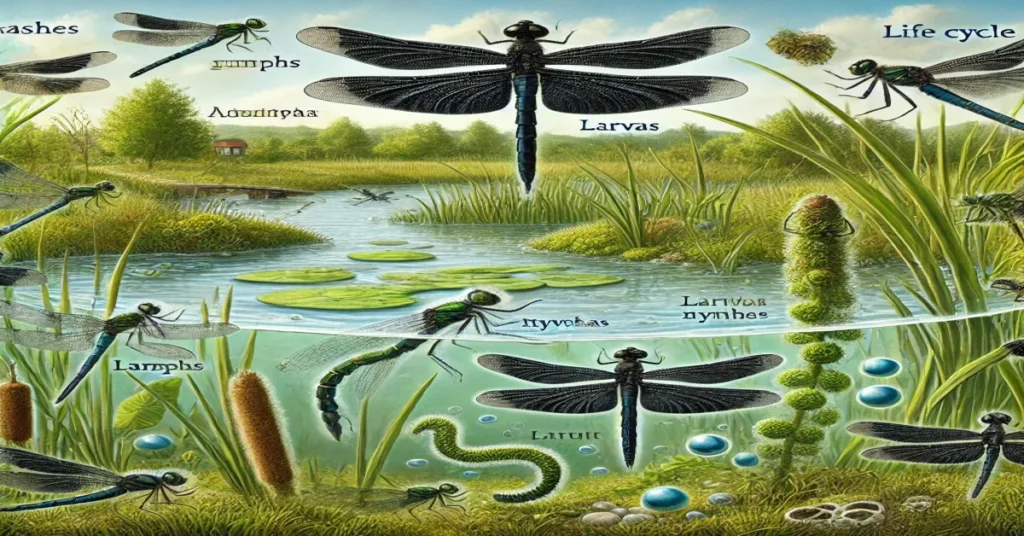
1. Preferred Habitat Conditions
The black dragonfly is typically found near slow-moving or still bodies of water with abundant vegetation, which provides shelter and food for their nymphs. Shallow wetlands with emergent plants, like cattails and reeds, are particularly suitable for dragonfly nymphs, as these plants offer hiding places from predators. Aquatic vegetation also supports the prey that nymphs feed on, such as small aquatic invertebrates.
In addition to water quality, dragonflies are affected by temperature and sunlight. Many black dragonfly species thrive in warm, sunny conditions where they can regulate their body temperature through basking. They are often seen perched on rocks or vegetation in sunny spots, where their dark bodies absorb heat, helping them maintain optimal body temperatures for hunting and flight.
2. Life Cycle and Development
The life cycle of a dragonfly includes three primary stages: egg, nymph, and adult. Each stage has unique ecological roles and habitat requirements:
- Egg Stage: Female dragonflies lay their eggs on the surface of water plants or directly into the water. The eggs then hatch into nymphs after a few weeks to a few months, depending on the species and environmental conditions.
- Nymph Stage: The nymph, or larval stage, is aquatic and can last several months to several years, depending on the species. Nymphs are voracious predators, feeding on small aquatic organisms such as mosquito larvae, tadpoles, and other small invertebrates. During this stage, dragonfly nymphs play an essential role in controlling populations of insects that could otherwise become pests.
- Adult Stage: After undergoing metamorphosis, the dragonfly emerges as an adult with fully developed wings. Adults are aerial hunters, preying on mosquitoes, flies, and other flying insects. Adult dragonflies live for a few weeks to a few months, during which they mate, lay eggs, and continue their role in maintaining insect population balance.
Ecological Roles of Black Dragonfly
The Black dragonfly plays a critical ecological role at both the larval and adult stages, contributing to ecosystem stability, biodiversity, and the regulation of insect populations. Their predatory behavior, role in nutrient cycling, and position within food webs make them valuable indicators of ecosystem health.
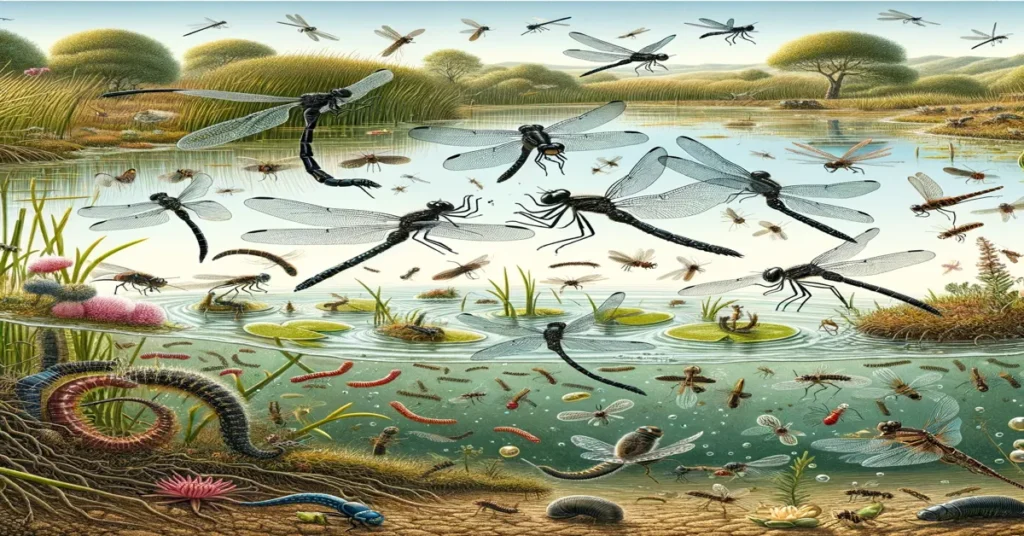
1. Natural Pest Control
As both nymphs and adults, the black dragonfly is an effective predator that helps control populations of various insects. Dragonfly nymphs feed on aquatic larvae, including those of mosquitoes, which helps reduce mosquito populations in wetlands and other aquatic habitats. By preying on mosquitoes, dragonflies indirectly help reduce the spread of mosquito-borne diseases, benefiting both ecosystems and human populations.
Adult dragonflies, in turn, feed on flying insects such as flies, gnats, and other small pests. Their aerial hunting skills allow them to catch prey mid-flight, making them efficient natural pest controllers. This predatory role supports the balance of insect populations within ecosystems, preventing overpopulation and the potential spread of insect-borne diseases.
2. Supporting Biodiversity and Ecosystem Health
Dragonflies are part of a complex food web and serve as both predators and prey. As nymphs, they are a crucial food source for fish, amphibians, and birds, while adult dragonflies are preyed upon by birds, spiders, and other larger insects. This position within the food web supports biodiversity, providing sustenance for a variety of species and contributing to the health of freshwater ecosystems.
Additionally, dragonflies are considered bioindicators, meaning their presence or absence can provide information about the health of an ecosystem. Because they are sensitive to pollution and changes in water quality, their populations reflect the state of their aquatic habitats. The presence of black dragonflies in an area indicates clean, well-oxygenated water and a healthy balance of vegetation and aquatic life.
3. Nutrient Cycling in Aquatic Ecosystems
Dragonfly nymphs contribute to nutrient cycling by feeding on various aquatic organisms and producing waste, which returns nutrients to the water. This nutrient recycling supports the growth of algae and aquatic plants, which form the foundation of the aquatic food web. By preying on small invertebrates and returning nutrients to the ecosystem, dragonfly nymphs help maintain the productivity and health of their aquatic habitats.
In turn, adult dragonflies contribute to nutrient cycling on land. As they die, their bodies decompose, returning nutrients to the soil and supporting plant growth. This transfer of nutrients between aquatic and terrestrial environments enhances ecosystem productivity and supports a broader range of species.
Adaptations and Behavioral Traits of Black Dragonflies
Black dragonflies possess several unique adaptations that enable them to survive and thrive in their environments. From specialized hunting techniques to temperature regulation strategies, these adaptations allow them to fulfill their ecological roles effectively.
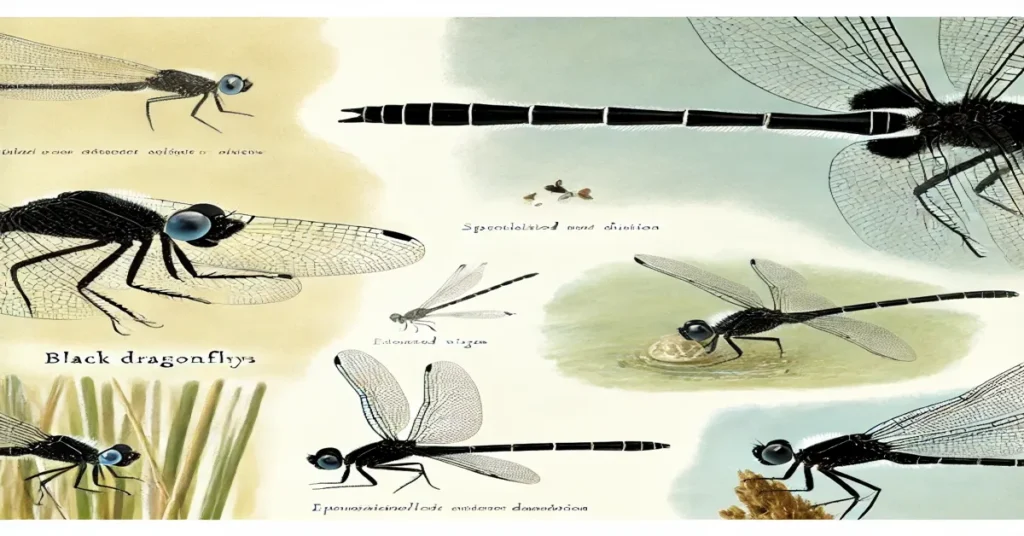
1. Visual and Flight Adaptations
Dragonflies are equipped with large, compound eyes that provide a wide field of vision, allowing them to detect prey and predators with remarkable accuracy. Their eyes are among the most complex in the insect world, containing thousands of individual lenses that detect movement and color. This acute vision is crucial for their aerial hunting strategy, enabling them to track and capture fast-moving prey in mid-air.
Dragonflies also have powerful flight muscles and long wings that allow for swift, agile flight. They can hover, fly backward, and change direction quickly, making them highly effective hunters. Black dragonflies, like other species, use these flight adaptations to pursue insects, evade predators, and engage in complex mating displays.
2. Thermal Regulation Through Coloration
The black coloration of these dragonflies is thought to aid in thermoregulation, especially in cooler climates or during early mornings and late evenings. Black bodies and wings absorb heat from the sun, enabling these dragonflies to maintain an optimal body temperature for flight and hunting. This adaptation is particularly useful in northern regions or higher altitudes where temperatures may drop significantly at night or during colder seasons.
By using their color to regulate body temperature, black dragonflies can remain active for longer periods, allowing them to hunt, mate, and reproduce more effectively than species that rely solely on environmental warmth.
3. Territorial and Mating Behaviors
Many black dragonfly species exhibit territorial behavior, particularly during the mating season. Males defend specific areas near water sources, where they compete for mates by displaying their colors, engaging in aerial displays, or chasing away rival males. These territories often include prime locations for egg-laying, such as areas with abundant vegetation or floating debris.
Mating displays often involve complex aerial maneuvers, with males showcasing their flight skills and coloration to attract females. This courtship behavior not only ensures that strong, healthy individuals reproduce but also maintains genetic diversity within the population, promoting resilience and adaptation within the species.
Conservation Challenges and the Future of Black Dragonflies
Despite their resilience, black dragonflies face several conservation challenges, primarily due to habitat loss, pollution, and climate change. As freshwater ecosystems are increasingly impacted by human activity, the survival of black dragonflies and their ecological contributions are at risk.
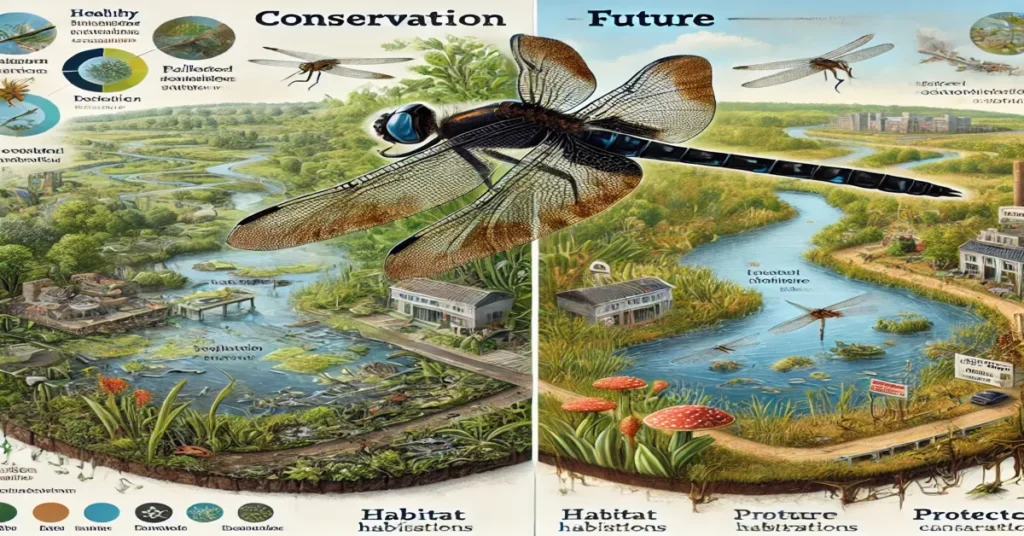
1. Habitat Loss and Degradation
One of the most significant threats to black dragonflies is habitat loss caused by urbanization, agriculture, and industrial development. Wetlands, ponds, and streams are frequently drained, altered, or polluted, reducing the availability of suitable breeding and feeding habitats. Habitat fragmentation further isolates populations, leading to reduced genetic diversity and increased vulnerability to environmental changes.
Conservation efforts that focus on protecting and restoring freshwater habitats are essential for supporting dragonfly populations. This includes creating protected wetland areas, managing water quality, and reducing habitat fragmentation to ensure that dragonflies have access to healthy ecosystems.
2. Water Pollution and Chemical Exposure
Dragonflies are highly sensitive to water quality, making pollution a major threat to their survival. Chemicals from agricultural runoff, industrial waste, and urban pollution can contaminate water sources, affecting dragonfly nymphs that rely on clean, oxygen-rich water. Heavy metals, pesticides, and other pollutants can be lethal to dragonfly larvae or disrupt their development, reducing population numbers and impacting the ecosystems they support.
Reducing pollution through sustainable agricultural practices, improved waste management, and stricter environmental regulations is crucial for preserving dragonfly populations. Efforts to monitor and clean polluted water sources can also help create safer habitats for dragonflies and other freshwater species.
3. Climate Change and Environmental Shifts
Climate change presents a complex challenge for black dragonflies. Shifts in temperature and precipitation patterns can alter the timing of dragonfly life cycles, potentially disrupting their breeding and feeding behaviors. Warmer temperatures may also affect the availability of prey or lead to changes in predator populations, impacting the balance of freshwater ecosystems.
In addition, rising temperatures can dry up water sources, reducing the availability of suitable breeding grounds for dragonfly nymphs. Conservation strategies that address climate change, such as preserving wetlands that act as carbon sinks and protecting habitats at risk of drying up, are essential for supporting dragonfly populations in the face of environmental shifts.
Conclusion
The black dragonfly is a fascinating insect with unique adaptations and critical ecological roles. From natural pest control and supporting biodiversity to contributing to nutrient cycling, these dragonflies play an essential role in maintaining healthy freshwater ecosystems. Their presence indicates clean water and balanced ecosystems, making them valuable bioindicators of environmental health. However, habitat loss, pollution, and climate change pose significant threats to their survival, highlighting the need for conservation efforts to protect these insects and their habitats.
By understanding and conserving The black dragonfly, we not only preserve the intricate web of life within freshwater ecosystems but also gain valuable insights into the health of our planet’s waters. Ensuring the survival of these insects is a step toward promoting biodiversity, supporting ecological balance, and fostering a sustainable future.
FAQs
1. What makes The black dragonfly different from other dragonflies?
The black dragonfly is distinguished by their dark coloration, which helps them with thermoregulation, camouflage, and mating displays in specific habitats.
2. Why is the black dragonfly considered good for the environment?
They control pest populations by feeding on insects like mosquitoes, support nutrient cycling, and serve as prey for other species, contributing to ecosystem health.
3. Where is the black dragonfly commonly found?
They are commonly found near slow-moving or still bodies of water like ponds, lakes, marshes, and rivers, where they breed and hunt for prey.
4. How do black dragonflies contribute to biodiversity?
They help maintain insect population balance, serve as prey for predators, and support aquatic food webs, which enhances biodiversity in freshwater habitats.
5. What threats do black dragonflies face?
Habitat loss, pollution, and climate change are major threats, impacting water quality and the availability of suitable breeding and feeding habitats.
6. How can we help conserve black dragonflies?
Supporting wetland conservation, reducing pollution, and addressing climate change impacts are crucial steps in preserving habitats essential for dragonfly survival.
Read More: Tree Bugs: Understanding Their Ecological Role and Environmental Impact

